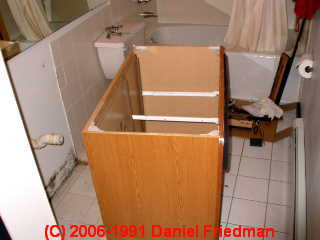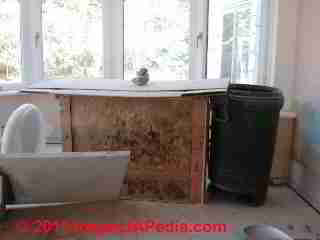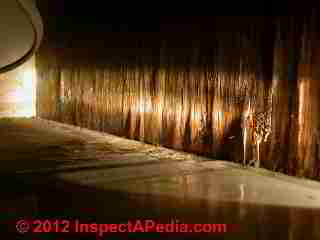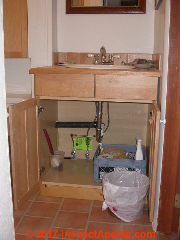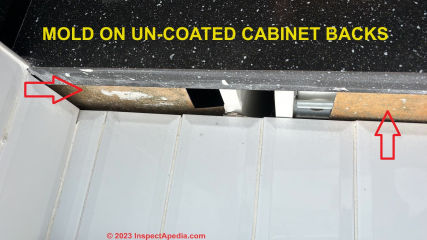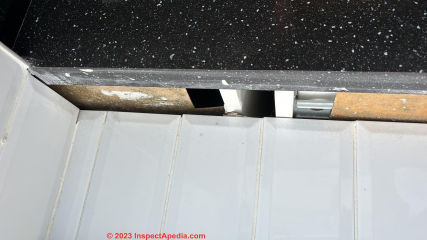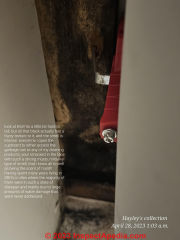 Mold-Contaminated Kitchen or Bathroom Cabinets
Mold-Contaminated Kitchen or Bathroom Cabinets
Cause, cure, prevention of mold on or in wall or base cabinets
- POST a QUESTION or COMMENT about inspecting, recognizing, and repairing defects in kitchen or bathroom cabinets & countertops
Kitchen & bathroom cabinet mold growth:
What are the causes of mold contamination found on, in, under or behind wall & base cabinets? Aside from obvious leaks, where else might water or moisture come from in cabinetry? What is the best way to clean or repair wet or moldy cabinets?
This guide to inspecting, installing, & repairing kitchen & bath cabinets & countertops describes common defects found in kitchen or bathroom cabinets - problems that can be found by visual inspection.
InspectAPedia tolerates no conflicts of interest. We have no relationship with advertisers, products, or services discussed at this website.
- Daniel Friedman, Publisher/Editor/Author - See WHO ARE WE?
Water Damaged & Moldy Kitchen or Bath Cabinets
A small moldy patch on a particleboard cabinet base (less than 1 sq. ft.) such as shown at the top of this page is unlikely to be a significant health hazard in a building, though it could bother someone with sensitive mold allergies or who is asthmatic. [Click to enlarge any image]
There may be more hidden mold below the cabinet base.
in this photograph of the cabinet base interior we notice that the mice don't seem disturbed by water, leaks, and mold - though their droppings make the cabinet unsanitary for food storage.
Below we illustrate another minor mold contamination case, due to water that leaked from a nearby shower to beneath the vanity base.
The vanity was replaced and the new unit first coated with a clear sealant on its hidden surfaces, then caulked at the floor and walls to keep water out of its hidden spaces.
But mold growth behind wall or base cabinets can be quite extensive.
Below: I've pulled a bathroom vanity base away from the wall for plumbing and other repair work.
in our next photo (below) and looking on the drywall that was previously covered by the vanity side and back, you can see mold contamination on the lower bathroom walls that were previously hidden by the cabinet back and side.
While the ceramic tile covering this floor, including below the base cabinet, is not normally a mold-friendly material, organic dust and debris that may accumulate under a cabinet can itself also hose mold growth if that space is also damp or wet.
After replacing or cleaning moldy surfaces where the cabinet is to be reinstalled, we cleaned the hidden surfaces of the vanity base using ordinary household cleaner.
When the base was thoroughly dry we sealed its underside with spray shellac (quick drying, convenient) to improve its moisture resistance and to thus make it less mold friendly in the future.
When we reinstalled the vanity base we also took care to seal it carefully both at the sink top splashboard and around the vanity base on the floor so that water spilled in those areas would no longer run under the cabinet and into a mold-friendly space.
Mold behind cabinets or on their other hidden surfaces may be both severe and totally hidden if a home has been flooded for any reason, as we illustrate with the photos below, showing mold on the previously-hidden sides of kitchen cabinets.
More examples of mold growing on just about anything in buildings can be seen
at MOLD GROWTH on SURFACES, PHOTOS.
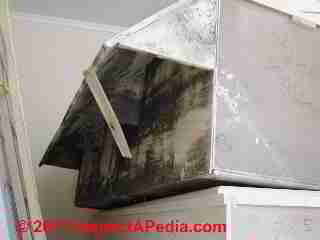
It would have been a mistake to leave these cabinets mounted to the wall of the home where they were found, even though mold was not visible on the room side of exposed wall surfaces.
Further investigation of the wall cavity behind where these cabinets had been mounted confirmed that the cavity side of the wall needed to be cleaned as well.
Leaks into kitchen or bath cabinets can occur in surprising places, as water can travel inside a building wall or along a floor where it passes into hidden spaces such as the interstitial space between a cabinet back and the building wall, or the cabinet base and the floor. A result can be hidden mold contamination.
My photo above shows that leaks in or below the dishwasher were affecting the lower left side of the kitchen base cabinet next to the dishwasher. Until the dishwasher was removed for replacement the extent of leakage was not so obvious.
Below is a delaminating sidewall of a kitchen base into which water had leaked, and if you enlarge the image you'll see water on the cabinet base shelf.
Expect to find mold on hidden wall or floor cabinets on hidden surfaces if a building has been flooded or subject to extensive leakage or wetting due to extinguishment of a fire.
The most common location of water damage to cabinets is of course at sinks or at the sides and bottoms of base cabinets adjacent to a leaky dishwasher (our two photographs above).
When the cabinet side or floor is badly water damaged the only durable repair is to either replace the cabinet or base entirely or to remove and replace or re-build its damaged components.
Illustrated in the kitchen base cabinet photo above, I've replaced a water damaged cabinet interior floor and covered-over a cleaned-up but water damaged area on the cabinet's rear wall.
Often we can remove sagged, water-damaged, moldy particleboard used as a base cabinet's interior floor and shelving. The new floor is tacked down or screwed to cleats so that in the future if we need to remove it to inspect, clean, or repair the space below it's easily accessible.
[Click to enlarge any image]
After making sure we have installed sufficient cleats or support we then install a new base floor and shelving using birch or other decent quality plywood that in turn is further coated on all sides with a clear lacquer or other sealant.
Below we take a different and easy approach.
Look at the interior floor of the bath vanity cabinet shown above. A previously-water-damaged particleboard cabinet floor was simply cleaned, left in place, and covered-over with a finished, solid wood floor giving a clean, attractive finished surface.
Watch out: all of this base cabinet repair or replacement will be a wasted effort if we don't find and fix the leaks that caused the trouble in the first place.
See SINK LEAK DIAGNOSIS & REPAIR for an example: replacing a leaky kitchen strainer basket that was leaking into the cabinet base.
Question: clogged kitchen base weep openings cause mold trouble?
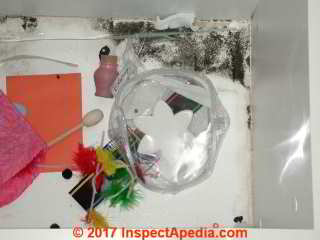 I have a base cabinet that has mildew/mold in it, it is not near a water source. Could it be from blocked weeping holes? No other cabinets are affected and this base cabinet is not next to sink or d/w. Also, the mold/mildew appears to only be on the shelf and the wall of the cabinet that is not attached to the wall of the house.
I have a base cabinet that has mildew/mold in it, it is not near a water source. Could it be from blocked weeping holes? No other cabinets are affected and this base cabinet is not next to sink or d/w. Also, the mold/mildew appears to only be on the shelf and the wall of the cabinet that is not attached to the wall of the house.
It is perplexing as we can't figure out why only certain places in the cabinet are moldy, other than when I searched outside I noticed the weeping holes had dirt in them.
I can unblock the weep holes should I pour some bleach in them (only 2) and if so how much? My brick house is 4 years old built on a slab.
Thank you, Dinah - 2017-08-04 This question was posted originally
at BRICK WALL DRAINAGE WEEP HOLES
Our photo of black mold on the bottom shelf of a kitchen base cabinet is from our files and is not Dinah's cabinet -Ed. [Click to enlarge any image]
Reply: base cabinet weep openings are not enough to prevent mold growth.
Dinah,
For other readers: here we're discussing weep holes in kitchen base cabinets, condensation, and mold in cabinets, and NOT brick wall weep and drain openings.
Looking at installation instructions for kitchen base cabinets such as units sold under the brands KraftMaid CoreGuard™ and Merillat, whose instructions look almost absolutely identical, we are warned that while the installer is to caulk around pipes that penetrate the cabinet bottom or back, she should not caulk weep holes placed in the interior flat base of the cabinet at its four corners.
If there's mold, at some point the area that supported the mold growth was probably damp enough to encourage that to occur.
The moisture may not necessarily be due to a leak, it could simply be moisture coming from condensation that's trapped in a space with poor air circulation and that gets an inlet of humid air in some building conditions.
I'm unclear about the role of weep holes on your base cabinets and would like to see the cabinets and the installation details (photos via page bottom CONTACT link). But here is some speculation that might help.
However in over half a century of working around and repairing or replacing cabinetry I've not myself come across a situation in which weep openings in a base cabinet prevented mold growth.
If we have an actual water or moisture source sending water or high moisture into an enclosed space, little teensy weep holes won't eliminate the risk nor prevent water or mold damage - too little ventilation passes in and out of our weepettes.
The weep openings might help avoid cabinet buckling or warping from temperature or air pressure changes, but that's speculation too.
I wouldn't pour bleach into the weep openings, since you'd be pouring water (it's not going to be 100% hypochlorite) into the space under the cabinet base where it'll be trapped.
The water content of the bleach solution will wet the area under the cabinet floor, yet the bleach won't be in contact with the (perhaps or even probably) moldy surfaces on the hidden, un-finished under-sides of the moldy cabinet base.
Instead, assuming the cabinet is not so badly water damaged that it needs replacement, you need to clean off the visible mold from the cabinet surfaces using any household cleaner.
If there is no nearby sink nor dishwasher, including via abutting cabinets underneath which water could be passing, then I'd assume something put into the cabinet base was wet, or cool temperatures inside the space are sometimes causing condensation.
Or perhaps there is an exterior moisture or water source from the slab floor below.
Steps to Fix your Moldy Cabinet
Where I've found that situation I've
- Taken care to not put wet stuff into the cabinet
- Made sure any abutting exterior walls are insulated and not leaking
- Added improved air circulation: in real problem cases I've added larger air openings to permit air to circulate in the cabinet (or closet) by installing a vent rectangle opening covered with something sufficiently attractive.
This image below is an example of how we ventilated an enclosed space at a pipe chase next to a cabinet to stop a condensation and sometimes freeze-up problem. .
Details about that approach are
at HEAT SOURCES to AVOID FROZEN PIPES
The K&B Cabinet guides at
our CABINET INSTALLATION & REPAIR MANUALS mention the weep holes in the cabinet base and warn the installer to keep them clear of caulk.
Also see BROWN HAIRY BATHROOM MOLD for a Q&A on the harmfulness of "hairy brown mold" found in a bathroom.
...
Reader Comments, Questions & Answers About The Article Above
Below you will find questions and answers previously posted on this page at its page bottom reader comment box.
Reader Q&A - also see RECOMMENDED ARTICLES & FAQs
On 2023-10-12 by InspectApedia DF (mod) - find and fix the leaks that caused moldy cabinets
@Wolfe,
The main control on which to focus is moisture and leaks, especially in the wall behind any cabinets and of course into the floor space below.
Sealing the surfaces you can access reduces their moisture-uptake and so reduces their propensity to support mold growth.
However spraying over existing mold contamination is never an effective repair and sealing an exposed surface won't address a mold colony in a wall, floor, or ceiling cavity.
Bottom line: leaks or high moisture in those "hidden" spaces behind or under cabinets are a troublesome source of mold contamination that's hard and expensive to clean-up.
When I install new bath or kitchen cabinets I now take care to use a sealant on the otherwise raw, un-sealed wood surfaces that are left by the cabinet manufacturer before I set the cabinet in place. Simply spraying with clear shellac works well.
That measure won't prevent a leak into the hidden space but it will reduce mold growth on the wood surfaces.
On 2023-10-12 y Wolfe
@InspectApedia Publisher,
I hope the decision could prevent the mold from dispersing and preventing it from getting worse at least for quite some time as the kitchen is still new. I will make sure to do an extra caution to make sure the kitchen get enough ventilation after this. Also, do you think painting the sealant inside the cabinets will be helpful too?
(Thank you so much for reading. I feel better having a conversation with experts regarding this issue. Let me know if you have any advise that I should be aware.)
On 2023-10-11 by InspectApedia Publisher (mod) - shortcuts leave mold reservoir in building
@Wolfe,
Thank you for the update. IT sounds as if doing all that would have been best was just more than the worker wanted to tackle.
You'll want to be alert for mold odors or mold reappearing, and perhaps to have a more-expert mason or home inspector examine the building outside wall surfaces to see if there are leak repairs needed in that brick exterior.
On 2023-10-11 by Wolfe - best approach to cleaning & sealing moldy chip board cabinet backs & sides
@InspectApedia DF,
Thank you for your reply. I called someone to remove the cabinet today but he can only removed one. Yes, the black one is the countertop and the white tiles is window area. The cabinet meet the house brick ( I don’t know how to explain, I wish I can attach a video here).
So, the mold possibly grow because of the brick which some parts are moist.
He supposedly paint the back cabinet with the sealant but he couldn’t take out the cabinets (?)
What he did was placing plywood behind them as much as he could so the back cabinets would not meet the bricks.
I don’t know if that was a good idea but I am quite unhappy that we couldn’t clean the back of the cabinets. (Additional note: I open the vent and kitchen hood every cooking time. I am very sad this happened.)
On 2023-10-10 by InspectApedia DF (mod) - mold-contaminated cabinet back surfaces (hidden)
@Wolfe,
I see what looks like heavy green mold on un-coated chipboard cabinet or countertop components, in just partial view.
In my opinion it is not possible to adequately remove and clean a surface like that without gaining access to all of it.
And where we see this much mold it's likely that more is to be found on hidden surfaces such as the back of cabinets against a wall (and possibly on the well), the under-side of cabinet bases (and possibly on the floor below), on the under-side of cabinet drawers etc.
From your photo I'm not sure of our orientation so I don't know just what I"m seeing. Is that black speckled surface a countertop ?
So sorry, but yes if you don't do the ugly work of tearing apart this installation you will be leaving what could be a troublesome mold contamination source in place. While no one can say for sure what mold is present (there is virtually never just one mold genera/species present), often on chipboard I find extensive species of Aspergillus sp. (harmful) and sometimes Trichoderma sp. (possibly harmful).
It may be possible to salvage these materials by
disassembling the installation enough that you can access all of the hidden surfaces
cleaning the surfaces of all surface mold - any household cleaner is fine
painting the surfaces with a fungicidal sealant - this reduces the moisture uptake of the chipboard and so makes the surfaces less friendly to future mold growth.
This procedure also lets you see any hidden drywall surfaces involved - where you will want to inspect for mold growth there as well.
Post more photos of what you find and we'll take it from there.
And none of the steps we've described will be a true repair unless you also find and fix the source of the mold first. Otherwise you risk the same problem reoccurring.
Sorry
DF
On 2023-10-10 by Wolfe
Hi, I really need your opinion about this issue please.
So, last week, I discovered that most of my appliances and food containers grew mold on the outside. It was very frustrating but I cleaned them with hot water and soap or with vinegar.
But then, I discovered there were mold inside the cabinets (like black patches). I thought it was not so serious so I wipe them and put moisture absorbers in each cabinets.
There real headaches was yesterday when I discovered through a small peek behind the cabinets that there’s actually more. Do I really need to take all the cabinets apart in order to clean the back cabinets or there’s any other way. Please please help me on this. Thank you.
On 2023-05-03 by InspectApedia Editor (mod) - sometimes moldy cabinet or sink top replacement is easier and less expensive
@Hayley Sproule,
1. While it's possible to clean the surface of a moldy wood product, then seal the surface to reduce its future moisture uptake and mold risk, that sink underside is in such an awkward position that cleaning thoroughly may be more trouble and cost than replacing the countertop.
2. Missing from that whole job plan is addressing the warnings that we give above on this page, so please read that material.
In particular, where else did water go? Under the sink base? Behind it? Adjacent areas? Unless enough exploring is done, at the very least by borescope & test cuts, the risk is that the job will have to be done over again, doubling its original cost.
So both you and your building management may want to beware of shortcuts that are penny wise and pound foolish.
On 2023-05-03 by Hayley Sproule
[Click to enlarge any image]
[Text in the image above reads: Look at this! Its a little bit hard to tell but all that black actually has a fuzzy texture to it, and the smell is intense. Every time I oopen the cupboard to either access the garbage can or any of my cleaning productds, you're smacked in the face with such a strong musty, mildewey type of smell, that I know all too well as being the scent of mold!
Having spent so many years living in SROs in cities where the majority of them were in such a state of disrepair and mainly due to large amounts of water damage that were never addressed.]
I've got a nasty black mold issue happening under my kitchen sink. The source was a incorrectly installed water filtration system by the previous tenant. Upon discovering the black mold I contacted my property management company to take care of the problem.
The 1st plumber they sent was shocked when he initially saw the mold that I had complained about. His exact words were, "how did they miss this?" a thought that had also crossed my mind as well!! The property management company then sent the same plumber back a 2nd time to remove the improperly installed water filtration system and to replace the damaged faucet that had also been overlooked by the PM company as well.
He then measured the counter tops telling me that he was taking the measurements for a replacement counter. I asked him how long he thought that might take? He explained that the repair process first required him to complete his assessment of the damage and then to submit a detailed report outlining what he thought was the best plan of attack in solving this issue. He left telling me that he didn't see it taking too long.
Nothing ever came of that conversation, nor did I hear back from the property management company as well.
So, I again contacted the PM company asking them when they were planning on continuing on with the replacement of my counter top? This time they sent a 2nd man, a contractor this time. He took 1 look under the sink and then made a similar comment as the 1st plumber...about how he was shocked that they didn't notice this issue prior to my moving in.
He then told me not to worry because he was here to take the measurements for my replacement counter. I replied, a little surprised, "take the measurements?" I continued on explaining the jyst of what I'd already experienced in this battle to simply just have this black mold dealt with!!!
As he was leaving I again asked if he had any idea of the timeline for this job? Of course he told me the exact same thing that the plumber had told me, "it should be done by the end of this month!" There being about 2.5 weeks left in March.
Again...no one ever came back to replace anything, nor did I hear another word back from the PM company either.
I just recently have made my 3rd repair request. I'm now no longer asking them, but more demanding that they deal with this issue immediately or that they would be hearing from my lawyer next!! I meant that too and am in the process of retaining council.
I'm just so saddened and disappointed that I'm having to deal with such a massive non- profit society in this manner. I feel so bullied and I'm not the only tenant that feels that same exact way! This societies sole purpose, how it's been able to become so massive is by offering and providing support for any and all women experiencing any form of abuse or trauma and are in need of support.
Its extremely overwhelming and stressful to move into an apartment under false pretenses, only to find out that its too late now to go back... that you're freaking stuck!! Its a terrible defeating feeling. It genuinely effects every aspect of your life and causes the quailty of it to decline.
With all the information available today that detail the effects that different types of mold have on a person, there's no excuse whatsoever for this PM company to be neglecting my black mold problem. I've read so many different facts from multiple sources about how black mold can potentially cause some pretty serious respiratory issues. For people with an compromised immune system, or that suffer from things like asthma or copd those symptoms could be much more serious.
Now I've had my lawyer contact this PM company and they've finally said that they are going to have their "contractor" come into my apartment tomorrow to "clean" this area. They've asked me to be out of my suite for 2 hours 3-5, while they are doing this clean.
My concern is that the reason they're requesting me to leave for those 2 hours is not for any safety reasons. More so because they are not wanting me to witness how they plan on actually handling this mold situation. I'm going to enclose 1 of the mold pictures, I wish I could send more...1 picture doesn't nearly show the extent of the damage.
My question after all of that....I'm sorry, I know... I thought that giving you the back story would help you to understand the situation better. Anyways do you think, from the picture, that the mold in question is able to be cleaned out of or off of the underside of the kitchen counter that is made of mdf, the top being laminate. I'm concerned that it's penetrated into the counter top beyond the point of being cleaned off.
That the PM company is more than likely going to stir up the toxic mold spores into the air of my apartment. Creating an opportunity for those toxins to now absorb into my fabric surfaced furniture and carpets and worse my plants!! 3 of which have died since I've moved into this apartment and now I know why exactly too! The black mold.
Please.let me known asap what your opinion and thoughts are regarding this problem. Thanks for your time and patience in helping me out with this situation.
On 2022-11-07 by InspectApedia (Editor) (mod) - wet dishes, garbage, poor air circulation contribute to in-cabinet mold
@Lindsey,
I have seen this exact problem from time to time in kitchen cabinets in two situations:
1. placing wet dishes in the cabinet and closing the door causes some surface mold growth, often Aspergillus sp. on the inside of the cabinet door - such as in your photo
2. on under-counter cabinets I find #1 above and also mold on the outer surface of the door, often simply due to poor air circulation, sometimes exacerbated by wet floors during floor washing;
I clean off such surface mold on cabinet surfaces using a spray household cleaner such as Windex or a mild spray cleaner that contains bleach.
I find that the problem will stay away for a year or so but may indeed recur.
On 2022-11-07 by Lindsey - moldy cabinets, no water source found
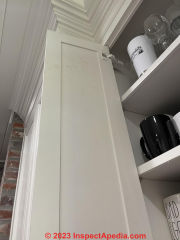
I am having somewhat of the same issue as someone else posted. I have a few sets of cabinets in my kitchen that are having mold issues. Mostly the top cabinets. Nowhere else in my house has mold issues only the cabinets.
There is no water source close to these upper cabinets. We also found mold in one of the cabinets in our fireplace mantle. It’s really bazaar. We’ve had multiple people inspect it and can not find a source on how this mold is getting in these spots. All on interior walls so there is not a probables with insulation. Any help is appreciated!
On 2021-11-20 by Inspectapedia Com Moderator (mod) - when do we need to pull out or take down cabinets to remove mold?
@Vera,
Some hard surfaces can be cleaned of mold.
But a concern I would have is where the mold is and where the leaks were.
For example leaks under and behind a vanity mean that there is risk of hidden mold on and in the wall cavity.
That would be a reason to pull the vanity out of place and inspect further.
On 2021-11-20 by Vera
Should you replace bathroom sink cabinet if serious black mold problem is present
On 2020-11-06 by danjoefriedman (mod) - risk of hidden mold behind or under cabinets
Owen:
Dry out of what: water, leaks, mold removal and sanitzing, application of finish?
Watch out: if you're asking about leaks that sent water behind a wall-mounted cabinet or under a floor cabinet, I've found water in those areas weeks after a wetting event, and sometimes problematic mold contamination as well.
Plastic surfaces don't absorb water as might wood, and so might themselves dry faster. But plastic or "melamine" cabinetry might also tend to hold water trapped in wall or floor spaces longer.
Some interesting research that touches on these problems, in addition to what we report in CABINET MOLD & WATER DAMAGE https://inspectapedia.com/interiors/Cabinet-Mold-Contamination.php
includes the following
Mold & Mycotoxin Hazards from Mold Hidden Behind or Under Cabinets
- Chew, Ginger L., Jonathan Wilson, Felicia A. Rabito, Faye Grimsley, Shahed Iqbal, Tiina Reponen, Michael L. Muilenberg, Peter S. Thorne, Dorr G. Dearborn, and Rebecca L. Morley. Mold and endotoxin levels in the aftermath of Hurricane Katrina: a pilot project of homes in New Orleans undergoing renovation [PDF] Environmental Health Perspectives 114, no. 12 (2006): 1883-1889. - retrieved 2023/11/11 original source: ehp.niehs.nih.gov/doi/full/10.1289/ehp.9258
Excerpt:
The supervisors visually inspected each house for roof leakage, standing water, and the extent of mold on walls, cabinets, floors, doors, trim, appliances, equipment, and heating ventilation/air conditioning ductwork. - Dobbs, Rachelle, and Greg Stockton. "Playing Hide and Seek with Mold." (promotional white paper) Infraspection Institute
- Kim, Hoikyung, Jee-Hoon Ryu, and Larry R. Beuchat. "Effectiveness of disinfectants in killing Enterobacter sakazakii in suspension, dried on the surface of stainless steel, and in a biofilm." Applied and environmental microbiology 73, no. 4 (2007): 1256-1265.
- Lstiburek, Joseph, Terry Brennan, and Nathan Yost. "Mold Testing." (2008) by Building Science Press, research report 0209, January 2002,
retrieved 2023/11/11 original source: fourseasonsroofingandsiding.com/Mold_Remediation/Mold_Testing_Waste_of_Time.pdf
Excerpts:
Mold may grow in hidden spaces. The most likely hidden spaces for mold growth are in exterior walls or ceilings or spaces that contain water pipes or air conditioning ducts that are open to crawl spaces or foundations materials.
Hidden spaces that frequently hide mold are:
behind or beneath cabinets, furniture, shelving, appliances fixtures, storage containers; under sinks, cabinets, cardboard boxes, toilets; on walls behind headboards, bookcases, sofas, dressers, file cabinets or toilets.
behind wall, ceiling or floor surfaces - under vinyl wallpaper, mopboards (the space under kitchen and bathroom cabinets), under carpet or vinyl flooring
...
Remember that mold may grow in hidden spaces such as within walls or beneath furniture and cabinets. Air testing will not tell you where the mold is coming from – it will only tell you that it is in the air at the instant in time the air sample was taken.
The air testing may provide an inference as to a source, but not the specific location. The source for the mold still has to be found.
Sampling is no substitute for inspection. However, inspection can often be a substitute for testing. - May, Jeffrey C., and Connie L. May. Jeff May’s healthy home tips: a workbook for detecting, diagnosing, and eliminating pesky pests, stinky stenches, musty Mold, and other aggravating home problems. JHU Press, 2008. - available also from Google Books
- Norris, Eric W. "Keeping buildings high and dry." Journal of Property Management 64, no. 2 (1999): 74-78.
Excerpt:
... kitchens, laundry rooms, laboratories, and commercial utility rooms all need to be protected from the damaging effects of water. Water seeping down into walls, wallpaper,
cabinets, and floors can result in major problems and costly repairs … - Pearce, McGregor, Patrick H. Huelman, Kevin A. Janni, Wanda Olsen, Robert T. Seavey, and Donald Velsey. Long-term monitoring of MOLD CONTAMINATION in FLOODED HOMES [PDF] Journal of Environmental Health 58, no. 3 (1995): 6-12.
Abstract:
One consequence of the spring and summer of 1993 has been an enormous number of water damaged homes in the upper midwestern United States.
A team of investigators with a variety of skills was assembled to monitor the effect of various cleaning, disinfecting, and drying strategies on indoor air quality of two flood damaged homes over one year's time. Additionally, six flooded homes in Marshall, Minnesota, were monitored twice, at seven and 17 months after flooding.
One component of the home study was periodic measurement of indoor mold spore levels. Measurements in all homes indicated that elevated mold levels persisted long after homes were cleaned and dried.
While ambient levels throughout the homes tended to return to normal after about a year, pockets of contamination remained at the end of the study.
Although no comparable pre-flood data are available, these results suggest that more effective decontamination procedures may be needed to prevent subsequent mold problems in flood damaged homes.
...
Excerpt:
After the water had been pumped out of the basements, the homeowners used a variety of cleaning strategies for their basements. Three of the houses were cleaned exclusively by professional cleaners. Two of the houses used professional cleaners, but did a lot of additional cleaning themselves.
The cleaning products varied. Cleaning was needed several times after the flood. Many furnishings were discarded, including furniture, cabinets, drywall, and carpeting. - Rosen, Gary, PhD., "Why are so many mold-sensitive patients not getting better?." (2020). Part 3 in Case Studies: what works or not with mold remediation and testing - author prohibits reproduction
Excerpt:
Not only moisture measurements and looking for earlier water stains, but also peeking behind baseboards, cabinet toe kicks, dishwashers, and other hidden areas … - Tang, Mengjia, Ningling Zhu, Kerry Kinney, and Atila Novoselac. Transport of indoor aerosols to hidden interior spaces [PDF] Aerosol Science and Technology 54, no. 1 (2020): 94-110. - retrieved 2023/11/11 original source: tandfonline.com/doi/full/10.1080/02786826.2019.1677854
This article makes the point that indoor mold contaminants can be transported into building cavities or hidden spaces . In our experience [DF] combined with future high moisture or leaks those contaminants can lead to significant but hidden mold reservoirs.
Abstract excerpt:s
Most studies on indoor aerosols have focused on the open spaces within buildings that are visible to occupants, while the hidden spaces in buildings receive much less attention. Indeed, little is known about the extent to which indoor aerosols are transported into closets, cabinets and drawers.
Aerosols deposited in these hidden spaces serve as a reservoir for particulate matter with the potential for resuspension within homes.
To investigate aerosol transport to indoor hidden spaces, a series of experiments were conducted in a full-scale test house.
...
For more sealed spaces like closed drawers within closed cabinets, the air circulation rates between the adjacent room and hidden space were substantially lower and a much lower fraction of the indoor aerosols deposited in these areas.
Nevertheless, the results indicate that at least one percent of the indoor aerosol source penetrated into the most remote indoor hidden spaces. - Haisley, Phil, Arch.D., AIA, FIELD INSPECTION PROTOCOL FOR INVESTIGATION OF MOLD DAMAGED BUILDINGS [PDF] (2002). Thesis, University of Hawaii School of Architecture, Thesis review committee: Tyau, Gordon DC, Mark Lawton, P. Eng, and J. David Miller. "
On 2020-11-06 by Owen S
Has any research been done or anyone have a source for how long it would take a kitchen cabinet to dry out? Melamine versus wood would also be helpful.
On 2018-11-03 y danjoefriedman (mod)
Irene
Let's try to get an answer to your perfectly-reasonable question: "Is it ok to continue to use kitchen exhaust fan in a kitchen that was mold-contaminated"
by getting some objective data: otherwise any answer offered by anybody is speculative arm-waving.
Start by assuming that the existing exhaust system runs and works normally.
1. Have the range hood exhaust fan system inspected: is it dirty with grease? If so it needs to be cleaned in any event, for fire safety? Is it dirty with mold: cleaning would make sense.
2. What's the cost of cleaning the existing system?
3. What's the cost of replacing the existing system?
If the cost to replace is less than the cost to clean then replacement would make sense.
On 2018-11-03 by Irene
If my kitchen had been contaminated and everything was thrown out can I still use my fan rang hood or do I have to buy a new one
On 2018-06-05 y danjoefriedman (mod)
as you may have noticed in the article above it's indeed common for mold to develop on the wood surfaces underneath or behind cabinets when those areas have been wet. That's because the wood is not sealed against moisture and it takes considerable time for such wet areas to dry out - giving plenty of time for mold growth to develop.
On 2018-06-05 by Vicki
hi, a coil holding water thats connected to pipe broke off flooding my bathroom. water went under the cabinet. do you think mold is present. I smell a weird odor. I don't know if its mold or the particle board. all my moisturizers, hairdryer and other things were in the cabinet. whats your advice. thank you.
...
Continue reading at CABINET CHOICES, Bath / Kitchen or select a topic from the closely-related articles below, or see the complete ARTICLE INDEX.
Or see these
Cabinets, Shelving, Casework, Trim Articles
- CABINETS & COUNTERTOPS - home
- CABINET CHOICES, Bath / Kitchen
- CABINET DESIGN GUIDE, KITCHEN
- CABINET DOOR HINGES
- CABINET FALLING HAZARDS
- CABINET INSTALLATION & REPAIR MANUALS
- CABINET MOLD & WATER DAMAGE
- CASEWORK, CABINETS, SHELVING INSTALLATION
- COUNTERTOPS, KITCHEN & BATH
- FORMALDEHYDE GAS HAZARD REDUCTION
- DOORS, INTERIOR
- HIDDEN MOLD, HOW TO FIND
- HOME CONSTRUCTION CATALOGS 1950
- INTERIOR FINISHES: BEST PRACTICES
- MOLD CLEANUP GUIDE- HOW TO GET RID OF MOLD
Suggested citation for this web page
CABINET MOLD & WATER DAMAGE at InspectApedia.com - online encyclopedia of building & environmental inspection, testing, diagnosis, repair, & problem prevention advice.
Or see this
INDEX to RELATED ARTICLES: ARTICLE INDEX to BATH & KITCHEN
Or use the SEARCH BOX found below to Ask a Question or Search InspectApedia
Ask a Question or Search InspectApedia
Try the search box just below, or if you prefer, post a question or comment in the Comments box below and we will respond promptly.
Search the InspectApedia website
Note: appearance of your Comment below may be delayed: if your comment contains an image, photograph, web link, or text that looks to the software as if it might be a web link, your posting will appear after it has been approved by a moderator. Apologies for the delay.
Only one image can be added per comment but you can post as many comments, and therefore images, as you like.
You will not receive a notification when a response to your question has been posted.
Please bookmark this page to make it easy for you to check back for our response.
IF above you see "Comment Form is loading comments..." then COMMENT BOX - countable.ca / bawkbox.com IS NOT WORKING.
In any case you are welcome to send an email directly to us at InspectApedia.com at editor@inspectApedia.com
We'll reply to you directly. Please help us help you by noting, in your email, the URL of the InspectApedia page where you wanted to comment.
Citations & References
In addition to any citations in the article above, a full list is available on request.
- In addition to citations & references found in this article, see the research citations given at the end of the related articles found at our suggested
CONTINUE READING or RECOMMENDED ARTICLES.
- Carson, Dunlop & Associates Ltd., 120 Carlton Street Suite 407, Toronto ON M5A 4K2. Tel: (416) 964-9415 1-800-268-7070 Email: info@carsondunlop.com. Alan Carson is a past president of ASHI, the American Society of Home Inspectors.
Thanks to Alan Carson and Bob Dunlop, for permission for InspectAPedia to use text excerpts from The HOME REFERENCE BOOK - the Encyclopedia of Homes and to use illustrations from The ILLUSTRATED HOME .
Carson Dunlop Associates provides extensive home inspection education and report writing material. In gratitude we provide links to tsome Carson Dunlop Associates products and services.



